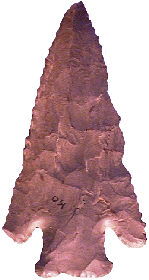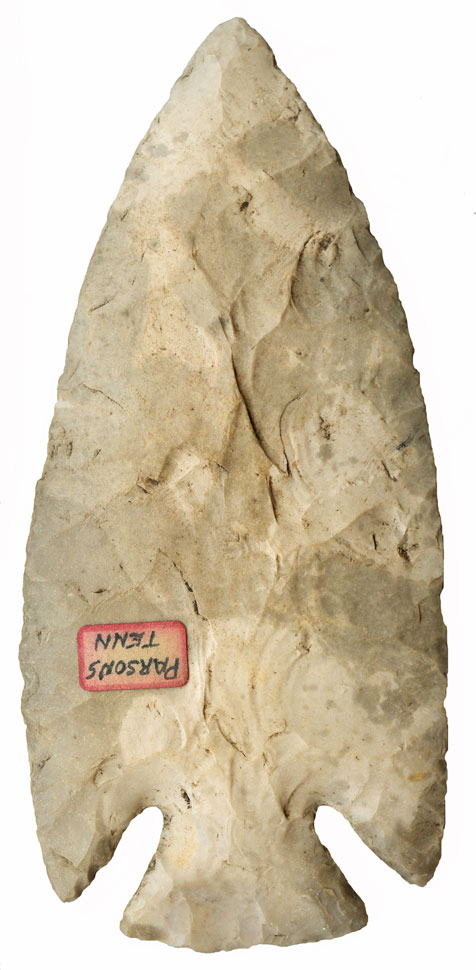



Point Type: LOST
LAKE a.k.a. Deep
Notch & Bolen Bevel Corner Notch
Also See: Bolen,
Cobbs
Triangular, Cypress Creek
I, St.
Charles, Dover Hill, Hardin, Kirk Corner Notched , Pine Tree, Thebes
Location: Southeastern United States
Associated Dates:
10000 - 8000 B.P. - Early Archaic
Morphology: Corner
Notched
General Description: The Lost Lake is a medium to large sized corner notched point that is beveled on one side of each face. The type is generally large with deep corner notches that often curve in and up from the edge of the blade. The terminal notch scars usually exhibit semicircular herzian cones. The blade shape varies considerably in the type due to the resharpening processes but is generally triangular. The blade terminates in with rounded barbs which gives the type a distinctive look. The blade shape ranges from excurvate to deeply incurvate. Over the lifespan of a point, the blade shape changed due to the use of bevel reworking techniques, generally becoming less excurvate to straight edged and then incurvate while continually becoming shorter with each rework episode. Cross sections range from biconvex on blades in pristine condition to rhomboid cross sections on highly reworked examples. Mose examples of the type are finely serrated along the blade edges and in general exhibit high quality flaking and a symmetrical outline.
The base on this point is usually ground and can be concave, convex , or straight and usually appears to be expanding due to the inward and upward corner notching style.
The Lost Lake type is known over much of the southeastern United States with a central focus on Alabama and Tennessee. The distribution range extends into the Ohio Valley and the type is known in Florida, Kentucky, southern Indiana, Ohio, Virginia and West Virginia. The point is called the Bolen Bevel Corner Notched in Florida and also has been known as the Deep Notch in the distribution area.
The size range of the Lost Lake point is between 49 mm and 91 mm in length, with the average being 63 mm. The width is between 35 mm and 48 mm wide across the barbs, 7 mm to 8 mm thick with a stem 12 mm to 15 mm long and 23 mm to 32 mm wide across the stem. The point was named by James W. Cambron and David C. Hulse for examples which were recovered from the Lost Lake area of Limestone County, Alabama.
About the Point Above (Left): The extremely large Lost Lake point pictured at the top left hand side of this page, is from Knox County, Tennessee. The point is made from a dark grayish flint material that is well patinated to a light brown, almost khaki color with a satin sheen. The point has three modern dings or chips, two on the right hand blade (upper blade edge in picture) and one on the basal edge. These dings reveal the original flint color and the amazing degree of patination present in the artifact. The edges of this blade are left hand beveled and are finely serrated. Additionally the lower or left hand barb has a slight chip off of the very end which is not modern. Overall, the point measures 88 mm in length, is 44 mm wide across the barbs, and is only 8 mm thick in mid blade just above the notches. The stem is 15 mm long and is 28 mm wide across the base of the stem. The base is ground and as mentioned above has a slight chip giving it an incurvate outline. The stem thickness is 5.5 mm. Catalog Number 30-135-D
About the Point Above (Right): The extremely large Lost Lake point pictured at the top right hand side of this page, was found in the town of Parsons, Decatur County, Tennessee. This blade is from the former Gus and Les Donovan collection of Yorktown, Indiana. The point is made from a blotchy light gray and cream dull Bayport chert material that is very highly patinated. The point has virtually no dings or chips on the blade edges however there is a tiny ding on the basal edge. The edges of this blade are not beveled at all and the blade is essentially in the same condition as made new. There is no evidence of retouch or serrations. The Donovan's suspected this blade was perhaps a ritual offering due to its extraordinary size and condition. The craftsmanship is excellent. The base is ground as are the sides of the stem. Overall, the point measures 138 mm in length, is 62 mm wide across the middle of the blade, and is only 11.3 mm thick in mid blade just above the notches. The stem is 22 mm long and is 36 mm wide across the base of the stem. The stem thickness is 6 mm. Catalog Number 2-111-R
References: Baker, Converse, Dragoo (e), Hranicky, Justice, Overstreet, Powell
© Copyright 1997 - 2008 LITHICS-Net WWW.LITHICSNET.COM
Use your Browser's BACK Button to return to the LITHICS-Net Index.